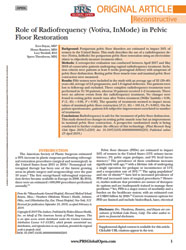“Role of Radiofrequency (Votiva, InMode) in Pelvic Floor Restoration”- New Study Published in the Plastic and Reconstructive Surgery – Global Open Journal
“Role of Radiofrequency (Votiva, InMode) in Pelvic Floor Restoration” by Spero J. Theodorou, MD, Erez Dayan, MD; Henry Ramirez, MD; and Lacy Westfall, RN, published in the Plastic and Reconstructive Surgery – Global Open Journal in April 2019 reviews the use of a radiofrequency device, Votiva, InMode for postpartum pelvic floor restoration using an electrostimulator to objectively measure treatment effect.
Votiva is a versatile radiofrequency workstation for women’s health and wellness, combining gentle volumetric heating with fractional coagulation of tissue. Used for vaginal rejuvenation, it is the first and only device on the market that helps to revive both the internal and external tissue of the vagina without the need for painful surgery or significant downtime. Votiva treatment combines 2 innovative radiofrequency devices – FormaV™ and Morpheus8 ™— to tighten loose tissues and reinforce vaginal skin structure and elasticity.
The researchers highlight that nonsurgical vulvovaginal therapy has been one of the fastest growing areas in plastic surgery and urogynecology over the past 10 years. This is mainly due to the attractive benefits – less downtime, discomfort, and cost — when compared to invasive surgical treatment. Moreover, RF treatment may provide particular benefit in cases of disturbance to the genito-pelvic floor, where stretching of the vaginal introitus can lead to decreased sexual function, lubrication, genito-pelvic sensation, stress urinary incontinence, bowel incontinence, chronic pelvic pain, and pelvic organ prolapse.
The study authors note that there were no adverse events from the Votiva treatment and found a significant correlation between treatment and maximal contraction of pelvic floor muscles. They also mentioned a prospective randomized study that is being conducted to further evaluate the efficacy and role of this technology. Patients have given a positive report and say that they felt subjective improvement correlated to number of treatments.

